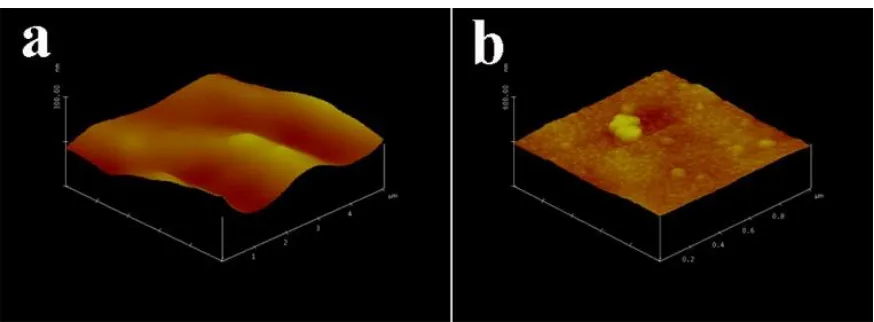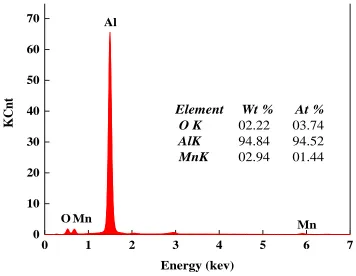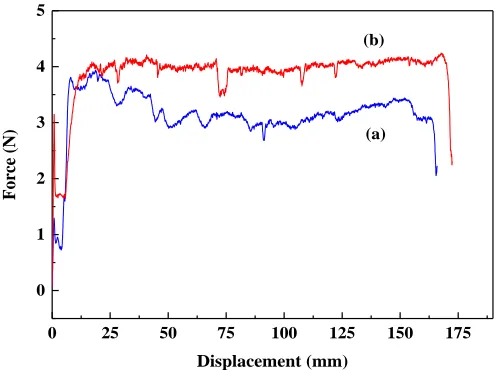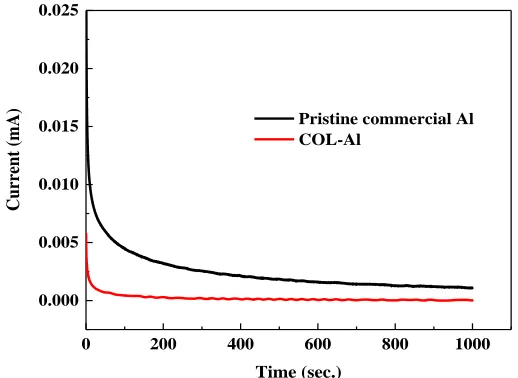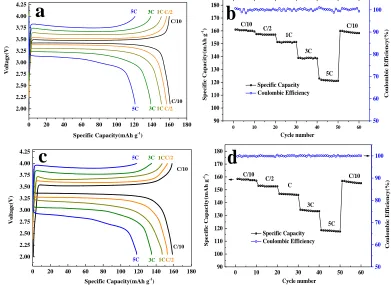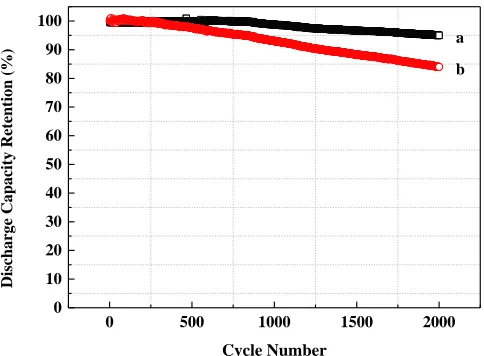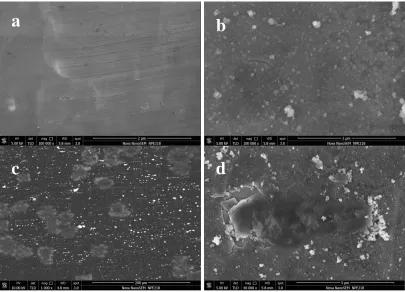Int. J. Electrochem. Sci., 10 (2015) 2324 - 2335
International Journal of
ELECTROCHEMICAL
SCIENCE
www.electrochemsci.org
Enhancing Performance of a Lithium Ion Battery by Optimizing
the Surface Properties of the Current Collector
Shuwen Kang1,3, Haiming Xie1, Wei Zhai3, Zi-feng Ma2,3, Rongshun Wang1,* and Weimin Zhang2,3,*
1
Department of Chemistry, National & Local United Engineering Laboratory for Power Batteries, Northeast Normal University, Changchun, Jilin 130024, PR China.
2
Institute of Electrochemical and Energy Technology, Department of Chemical Engineering, Shanghai Jiao Tong University, Shanghai 200240, China.
3
Sinopoly Battery Research Centre, Shanghai 200241, China.
*
E-mail: wangrs@nenu.edu.cn; wm_zhang@sjtu.edu.cn
Received: 12 December 2014 / Accepted: 12 January 2015 / Published: 19 January 2015
A thin uniform and compact oxide layer (COL) was synthesized a on an Al foil as a current collector for Li-ion battery cathode by an oxidation process using KMnO4 as an oxidant. The oxide composite
mainly consists of manganese and aluminium oxides which were determined by EDX technique. The morphologies of the as-prepared COL modified Al current collector were characterized by AFM and SEM. Electrochemical measurements were performed to evaluate the corrosion behaviour of the current collectors in Li-ion battery (LIB) electrolyte. And the adhesion property of current collectors’ surface to battery electrode materials layer was examined using a peel test technique. It was found the COL on an Al current collector can effectively protect it from corrosion and also exhibits good adhesion properties to the electrode materials layer. Such good properties are quite beneficial to the electrochemical performance and cyclability of Li-ion batteries for extensive cycle life test evaluations which were confirmed by electrochemical characterizations and cycle life tests.
Keywords: lithium ion battery; anti-corrosion; adhesion; current collector.
1. INTRODUCTION
Improved cycle life, gravimetric and volumetric energy densities, and power densities of the Li-ion batteries require not only high performance cathode and anode materials, but high anti-corrosion ability of electrode and good adhesion properties within the electrode composite and at its interface with the current collector. Only with these optimized components, the Li-ion batteries can maintain to deliver the designed energy and power output under operation conditions.
Typically good adhesion properties between the electrode composite and current collectors’ interface should be achieved to deliver the designed power output and cyclability throughout the service period. In order to enhance the surface adhesion properties of the current collectors, surface roughing process, roll pressure, and addition of special binders are commonly employed to maintain the mechanical durability of the electrodes. Such mechanical enhancements have proven beneficial to the cyclability and performance of batteries. [13-15] Besides, in practice, commercial current collectors are often not 100% pure in their metal content. Trace of impurity content may result in continued corrosion of current collectors which can lead to a significant contribution to the Li-ion batteries’ internal resistance of cells, which further results in power and capacity fade. [16] Therefore, special treatment on current collectors to form protect layer on their surface is conducive to maintain the battery performance. Normally, a metal can passivate to enhance its anti-corrosion ability via different ways such as solvent chemisorptions, air-formed layer, alloying additions of transition metals, hydroxide/oxyhydrogxide formation, and a salt film consisting of metal cations and anions from the electrolyte, etc. [17-22] However, to obtain a uniform and effective protect layer on current collectors is still so far challenging.
Herein we demonstrates in this study a simple and low cost strategy which was employed to prepare a protective oxide thin layer coated Al foil as a cathode current collector for Li-ion batteries. In this work, we also found the formation of the COL on Al foil not only improves the anti-corrosion ability of the current collector in Li-ion battery electrolyte, but enhances its adhesion property to LiFePO4 cathode laminate. The as-prepared current collectors were characterized physically and the
related corrosion behavior was investigated by electrochemical technique. The corresponding current collectors were employed to fabricate into Li-ion full cell batteries and the related cycle life evaluations were performed.
2. EXPERIMENTAL
2.1 Materials
Potassium Permanganate (KMnO4), Sodium Hydrooxide (NaOH), Sodium Carbonate
(Na2CO3), Sodium dodecyl sulfate (SDS), Potassium fluozirconate (K2ZrF6), and Nitrate Acid (HNO3)
were purchased from Sinopharm Chemical Reagent Co., Ltd, China and used as received. The Iron phosphate (LiFePO4) was commercial product from Aleees Eco Ark Co., Ltd., Taiwan. The electrolyte
2.2 Synthetic procedures
The compact oxide layer on aluminium current collector (denoted as COL-Al) was prepared as follows. A commercial pristine Al current collector was used and cleaned up with acetone for several times to remove organic species on the surface, and then subjected to alkaline (an aqueous solution containing 0.75 M NaOH and 0.125 M Na2CO3) treatment to enhance its adhesion with the oxide
composite layer. The resulted hydroxides and oxides by NaOH and Na2CO3 were washed out from the
aluminium collector with diluted HNO3 solution and rinsed with deionized water to remove the
residual acid. The cleaned current collector was immersed in an aqueous solution containing 0.03 M KMnO4, 0.15 mM SDS, and 0.15 mM K2ZrF6 for 20s. The pH value of the solution was maintained at
2 by adjusting the concentration of HNO3 in the solution for the reaction. The modified Al foil was
washed with deionized water to remove the excess reactants and dried in a vacuum oven at 60 ℃ for 3 hours.
2.3 Characterizations
The surface properties of the aluminium foils before and after treatment were characterized with an atomic force microscope (AFM, Multimode Nanoscope). The morphologies and EDX analysis of the Al foils surface were investigated using a FEI Nova NanoSEMTM 450 scanning electron microscope (SEM) equipped with an EDAX genesis 2000 (Amtek GmbH, Wiesbaden, Germany). Powder X-ray diffraction (XRD) measurements were performed using a Bruker D8 diffractometer with Cu Kα radiation. The room-temperature conductivity of the current collectors was measured by a Jandel standard four-probe conductivity meter (Jandel Engineering Limited, U.K.). The peel tests were conducted using a CMT8501 Electromechanical Universal Testing Machine (MTS Systems (China) Co., LTD) to evaluate the adhesion properties of electrode. The procedure was similar to the reported elsewhere [13].
2.4 Electrochemical measurements
The chronoamperometric curves were recorded using a homemade air-proof three-electrode set up connected with a CHI 760E bipotentiostat (CH Instruments, USA). The working electrodes were COL-Al and commercial pristine Al current collectors. A lithium foil and a lithium ring were served as counter and reference electrode respectively. The assembly was conducted in an argon filled glove box. The electrolyte was 1.0 M LiPF6 dissolved in a 50:50 w/w mixture of ethylene carbonate and
diethyl carbonate. Electrochemical impedance spectra were measured using the same three-electrode cell while the working electrodes were Al current collectors with LiFePO4 cathodic materials which
an argon-filled glove box. The working electrodes were made of 91.7 wt% LiFePO4, 3.7 wt% carbon
black, and 4.6 wt% LA133 binder which were supported on Al current collectors. Lithium foil was used as both reference and counter electrode. The Celgard 2000 microporous membrane was used as separator. For the full cell assembling, the anode was a thin film containing 95 wt% graphite, 1 wt% carbon black, and 4 wt% LA133 binder which were supported on a Cu current collector. The cycle life tests of the full cells were conducted using our commercially designed 25 Ah single full cell battery device which were assembled and activated in our factory (Sinopoly Battery Limited, Jilin, China). The long-term cycle life tests were conducted with a potential window between 2.0 and 3.8 V using a BTS 5V/50A Battery Testing System (Neware Electronic Co., China) at a 1 C charge-discharge rate.
3. RESULTS AND DISCUSSION
Normally commercial pristine Al foil current collector has a very smooth and white surface with a low effective interfacial area. In air a thin and dense oxide (Al2O3) passive layer often forms on
its surface due to the activity of Al element. To enhance the surface property which is conducive to form a robust electrode, we synthesized a high surface area oxide passive layer which was expected to replace the smooth Al2O3 layer on the Al foil by a simple and quick dip-soak method. In the treatment
process by KMnO4, the presence of K2ZrF6 is critical for the formation of high quality and robust
compact oxide film on the Al foil. The SDS used here serves as a surfactant which helps form uniform oxide layer. After the oxidation by KMnO4 solution, a thin and light yellow film was formed on the
[image:4.596.80.517.469.630.2]surface of Al foil.
Figure 1. AFM images of the surfaces of pristine commercial Al foil (a) and COL-Al current collector
(b).
0 1 2 3 4 5 6 7
0 10 20 30 40 50 60 70
Element Wt % At %
O K 02.22 03.74 AlK 94.84 94.52 MnK 02.94 01.44
Mn
KCnt
Energy (kev) O Mn
[image:5.596.120.476.67.343.2]Al
[image:5.596.115.482.396.686.2]Figure 2. EDX spectrum of COL-Al and XRD patterns of the two Al current collectors.
Figure 3. SEM image and elemental mapping images of the COL-Al surface.
all the elements were distributed throughout the surface and also the surface was functioned with a mixture of manganese and aluminum oxides. EDX measurements were carried out to determine the components content for the oxide layer. The corresponding EDX result shown in Figure 2 presents that the atomic ratio of Mn to O is 1.44:3.74. It is clear that the atomic proportion of O is excess in all the stoichiometric ratios of Mn to O in various manganese oxides. That suggests that the surface composite mainly consists of not only manganese oxide, but aluminium oxide. Assuming all the O is from the structure of oxides, the molar ratio of manganese oxide to aluminium oxide is 1.44 to 0.57 on the current collector surface.
The adhesion strength plays a critical role for keeping contact of the electrode materials coating and the current collector, which will greatly influence mechanical stability of the electrodes and further the cyclability of the battery. In order to evaluate the adhesion property difference for the different surfaces, we casted a very thin cathode laminate layer (50 μm) on the Al foils and then performed 180°peel test to evaluate the adhesion of the Al current collectors with LiFePO4 /binder/carbon black
layer in a LIB cathode.
0 25 50 75 100 125 150 175 0
1 2 3 4 5
Fo
rce
(
N)
[image:6.596.174.423.326.511.2]Displacement (mm) (a) (b)
Figure 4. Force-displacement curves of the LiFePO4/binder/carbon black on pristine Al (a), and
COL-Al current collector (b) in peel tests.
From the force-displacement curves shown in Figure 4, the average peel forces are 3.93 N and 3.04 N for LiFePO4/binder/carbon black layer on COL-Al and the pristine Al foil current collector,
0 200 400 600 800 1000 0.000
0.005 0.010 0.015 0.020 0.025
Current
(
mA)
Time (sec.)
[image:7.596.169.428.74.263.2]Pristine commercial Al COL-Al
Figure 5. Chronoamperometric curves of Al current collectors in LIB electrolyte at 4.2 V vs Li+/Li.
Except aluminium element, pristine commercial Al current collector normally consists of trace of other elements such as Cu, Fe, and Si, etc. Exposing to electrolyte, these elements connected with Al component will form corrosion cells even without applied potential which will lead to gradual etching of Al. Typically, a thin and dense oxide passive coating on Al surface can prevent these cells from exposing to electrolyte and thus protect the current collector from corrosion. [22] This oxide layer is very thin and will not bring impairment to the conductivity. Figure 5 show chronoamperometric curves of Al current collectors in LIB electrolyte at 4.2 V vs Li+/Li. It can be seen that the anodic current of pristine commercial Al is higher than that of COL-Al. That implies the presence of oxide layer on the current collector can effectively slow down the corrosion process. Actually, the corrosion of current collectors contributes adverse consequences to the performance of Li-ion batteries. Such behavior not only decreases the effective interfacial area of the current collector but increases the resistance of the interface between the cathode and electrode materials layer. Server corrosion is likely to lead to the cracking of electrodes and also the aluminum ions in the electrolyte which etched out from the corrosion process may impair the performances of both the cathode and anode[16]. Therefore the protective layer on the current collector is expected to enhance its anti-corrosion property and help maintain energy output as well as cyclability in a long-term operating.
of the electrode was not changed with its presence. Also, no additional arc loop was observed at high frequency region in the EIS of COL-Al electrode which shows the COL on the Al foil surface did not change the bulky properties of the Al current collector. Therefore we can conclude that the conductivity and capacitance of the electrode did not undergo clear impairment after the oxidation treatment process.
0 50 100 150 200 250 300 0 100 200 300 400 -Z" ( )
Z' ()
a
b
Figure 6. Electrochemical impedance spectra of electrodes obtained at open circuit potential (a.
electrode with COL-Al current collector; b. electrode with commercial Al current collector).
0 20 40 60 80 100 120 140 160 180
2.00 2.25 2.50 2.75 3.00 3.25 3.50 3.75 4.00 4.25 Voltage(V)
Specific Capacity(mAh g-1)
C/10 C/2 1C 3C 5C C/10 C/2 1C 3C 5C
a
0 10 20 30 40 50 60
90 100 110 120 130 140 150 160 170 180 Sp ec ifi c Capacity (mAh g -1) Cycle number Specific Capacity Coulombic Efficiency 1C 3C 5C C/10 C/10 C/2 50 60 70 80 90 100 Coulom bic Effi ciency(%)
b
0 20 40 60 80 100 120 140 160 180 2.00 2.25 2.50 2.75 3.00 3.25 3.50 3.75 4.00 4.25 Voltage(V)
Specific Capacity(mAh g-1
) C/10 C/2 1C 3C 5C C/10 C/2 1C 3C 5C
c
0 10 20 30 40 50 60
[image:8.596.194.402.171.337.2]90 100 110 120 130 140 150 160 170 180 Sp ec ific Capacity (mAh g -1) Cycle number Specific Capacity Coulombic Efficiency C 3C 5C C/10 C/10 C/2
d
50 60 70 80 90 100 Coulom bic Efficiency(%)Figure 7. Galvanostatic charge-discharge curves, discharge rate capabilities and coulombic efficiency
[image:8.596.102.493.417.702.2]
To verify the effect of superior anti-corrosion and adhesive properties of the current collector on lithium ion battery performance and durability, we carried out charge/discharge measurements at various rates ranging from 0.1 C to 5 C for the LIBs with different current collectors which are shown in Figure 7. The ΔE values evaluated from the difference between charge and discharge potential plateaus were 0.061 V and 0.150 V at a rate of 0.1C for the LIBs using COL-Al and pristine Al current collector, respectively. The corresponding values increased with the increased rates and were respectively boosted up to 0.648 V and 1.069 V at the rate of 5 C. It is quite clear that the electrochemical polarization of the electrode was decreased with the introduction of COL at all the rates. The reduced electrochemical polarization can be ascribed the enhanced adhesion and anti-corrosion ability of the current collector surface [28-29]. These results are well consistent with the above EIS measurements. We can also observe that the specific capacities of the COL-Al LIB increased at all the rates. As can be also seen from Figure 7a and 7c, the specific capacities of the LIB with COL-Al are 4 ~ 8 mAh g-1 higher than that with pristine commercial Al current collector for all the rates. That further confirms the low electrochemical polarization of the electrodes which benefits the fast electrode kinetics and thus deliveries higher energy for the LIBs.
The merits of higher anti-corrosion ability and better interfacial contact property of the COL-Al were highlighted by long-term cycle life testing. We carried out life tests for the LIB full cells using pristine commercial and OCL-Al foils as current collectors respectively. The design capacity of the batteries is 25 Ah which is same as our commercial products volume, for we expected to examine the possibility for realizing the achievement in real commercial applications. The test results are shown in Figure 8. The discharge capacity of the cell with pristine commercial Al foil as cathode current collector experienced fading at No. 250 cycle which decreased to 85% of the initial capacity after 2000 cycles. It illustrates that the texturing surface of the Al current influences the capacity retention of the cells mainly on an extended time scale, because we can observed that the cell with bared Al current collector as well did not have a significant capacity fading when the cycle number was less than 250 [30].
0 500 1000 1500 2000 0
10 20 30 40 50 60 70 80 90 100
Disc
harge Capacity Retentio
n (
%)
Cycle Number
a
b
Figure 8. Cycle life test of LiFePO4/graphite full cells (LIB using COL-Al current collector (a) and
[image:9.596.178.420.530.708.2]
Figure 9. SEM images of pristine commercial Al current collector before (a) and after (c) long-term
cycle life test in full cells, and COL-Al current collector before (b) and after (d) cycle life test.
While the battery with COL-Al foil current collector for cathode showed much better cyclability, with no significant discharge capacity drop was observed until 825 cycles. Even after 2000 charge-discharge cycles, the capacity still presented with 95% retention of the initial capacity. We performed morphology investigation for the surface of the current collector after cycle tests. The electrode materials layer was carefully removed from the current collector. The SEM investigation was performed and the images of the surfaces of the current collector are shown in Figure 9 (c) and Figure 9 (d), respectively. We observed that some big corrosion pins together with many small ones on the surface of the pristine commercial Al current collector after 2000 cycles. In comparison, no corrosion pin was observed on the surface of COL-Al current collector while a few areas became smooth with bumps disappeared after the cycle life test. The results showed that the presence of COL cannot completely prevent the Al current from corrosion as other coatings [28, 31]. However, due to the protection by the COL, the corrosion did not reach the bulk Al current collector. This illustrates the COL can be more effective to be a corrosion inhibitor than other coatings in lithium ion batteries scale. Especially the oxide layer can effectively protect the Al current collector from corrosion in the extensive cycling. This result is in good consistence with the electrochemical measurement above.
4. CONCLUSIONS
In summary, a thin COL consisted of manganese and aluminium oxides was synthesized on an Al current collector for Li-ion battery cathode to reinforce its adhesive and anti-corrosion properties by
a
b
a simple oxidation process. The smooth surface of Al foil became rough with bump pattern structure after the modification. The electrochemical characterizations showed the presence of COL on the Al current collector can greatly enhance its anti-corrosion ability. The peel tests showed the COL-Al has a better adhesion property than the pristine commercial Al current collector. Electrochemical characterizations showed that the COL effectively low the electrode polarization and enforce the LIB’s performance. The Al current collectors were also fabricated into a 25 Ah Li-ion battery which is identical to our commercial cell as a cathode current collector to evaluate the cycle performance. Extensive cycle life tests showed the Li-ion battery still had a discharge capacity of 95% retention of the initial capacity after 2000 cycles, in comparison with that with pristine commercial Al current collector 85% capacity retention. Such an oxide layer coated Al foil presents itself a promising current collector for high cycle life Li-ion batteries.
Moreover, such a preparation approach for Al current collector modified with the COL is simple, cost-effective and can be utilized for large-scale lithium ion batteries devices.
ACKNOWLEDGEMENTS
We would like to thank the finical support from the National High Technology Research and Development Program of China (SS2012AA110301, 2013AA110103), Science Foundation for Young Teachers of Northeast Normal University (No. 12QNJJ014), and the Program for New Century Excellent Talents in University.
References
1. R. Marom, S. F. Amalraj, N. Leifer, D. Jacob and D. Aurbach, J. Mater. Chem., 21 (2011) 9938. 2. N.-S. Choi, Z. Chen, S. A. Freunberger, X. Ji, Y.-K. Sun, K. Amine, G. Yushin, L. F. Nazar, J. Cho
and P. G. Bruce, Angew. Chem., Int. Ed. 51(2012) 9994.
3. G. Zhang and X. W. Lou, Angew. Chem., Int. Ed. 53 (2014) 9041. 4. J. B. Goodenough, Energy Environ. Sci., 7 (2014) 14.
5. J. B. Goodenough, Acc. Chem. Res. 46 (2012) 1053.
6. J. B. Goodenough and Y. Kim, Chem. Mater. 22 (2009) 587. 7. A. Kraytsberg and Y. Ein-Eli, Adv. Energy Mater. 2 (2012) 922.
8. M. V. Reddy, G. V. Subba Rao and B. V. R. Chowdari, Chem. Rev. 113 (2013) 5364. 9. C. M. Julien and A. Mauger, Ionics 19 (2013) 951.
10.J. Liu and X.-W. Liu, Adv. Mater. 24 (2012) 4097.
11.Y. Zhao and L. L. Daemen, J. Am. Chem. Soc. 134 (2012) 15042.
12.G. Zhang, H. B. Wu, H. E. Hoster and X. W. Lou, Energy Environ. Sci. 7 (2014) 302. 13.B. Son, M.-H. Ryou, J. Choi, T. Lee, H. K. Yu, J. H. Kim and Y. M. Lee, ACS Appl. Mater.
Interfaces 6 (2013) 526.
14.M.-H. Ryou, J. Kim, I. Lee, S. Kim, Y. K. Jeong, S. Hong, J. H. Ryu, T.-S. Kim, J.-K. Park, H. Lee and J. W. Choi, Adv. Mater. 25 (2013) 1571.
15.L. Chen, X. Xie, J. Xie, K. Wang and J. Yang, J. Appl. Electrochem. 36 (2006) 1099. 16.T. C. Hyams, J. Go and T. M. Devine, J. Electrochem. Soc. 154 (2007) C390.
17.D. A. Shifler, P. J. Moran and J. Kruger, J. Electrochem. Soc. 141 (1994) 934.
19.S.-T. Myung, K. Izumi, S. Komaba, Y.-K. Sun, H. Yashiro and N. Kumagai, Chem. Mater. 17 (2005) 3695.
20.S.-T. Myung, K. Izumi, S. Komaba, H. Yashiro, H. J. Bang, Y.-K. Sun and N. Kumagai, J. Phys. Chem. C 111 (2007) 4061.
21.L. J. Krause, W. Lamanna, J. Summerfield, M. Engle, G. Korba, R. Loch and R. Atanasoski, J. Power Sources 68 (1997) 320.
22.S.-T. Myung, Y. Hitoshi and Y.-K. Sun, J. Mater. Chem. 21 (2011) 9891. 23.L. Chen, A. van Zomeren and J. Schooman, Solid State Ionics 67 (1994) 203.
24.W. C. West, N. V. Myung, J. F. Whitacre and B. V. Ratnakumar, J. Power Sources 126 (2004) 203.
25.K. Kamala Bharathi, L. N. Patro, C. V. Ramana, J. Mater. Sci. 48 (2013) 5063 26.Y. Bai, P. Qiu, Z. Wen, S. Han, J. Alloys Compd 508 (2010) 1
27.S.-C. Jheng, J.-S. Chen, Int. J. Electrochem. Sci. 8 (2013) 4901
28. S. J. Rrabakar, Y.-H. Hwang, E. G. Bae, D. K. Lee, M. Pyo, Carbon 52 (2013) 128
29.S. Nakanishi, T. Suzuki, Q. Cui, J. Akikusa, K. Nakamura, Trans. Nonferrous Met. Soc. China 24 (2014) 2314
30.C. Lecoeur, J. – M. Tarascon, C. Guery, Electrochem. Solid St. 14 (2011) A6 31.Y. Li, P. S. Fedkiw, Electrochim. Acta 52(2007) 2471
